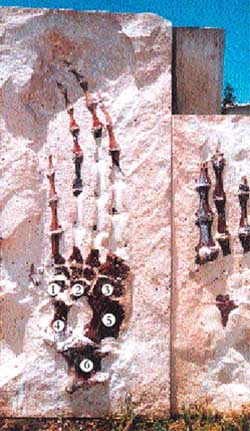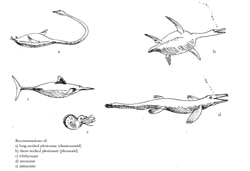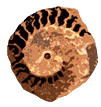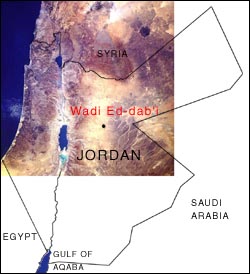Candidates
Now
we have an animal with flaps and we have an age given by the NRA
to the stone (71.3 to 55 million years ago). We must add one more
fact to help narrowing down the dates. The mass-extinction that
ended the life of 75% of all animal species, which was caused by
a meteorite, the size of Amman (10 kilometers across), that struck
the earth near the village of Chicxulub on the cost of Mexico, This
great impact caused dust, smoke and soot (which reached Jordan and
deposited the K-T boundary, as geologists call it, and which in
now being identified in several locations in Jordan) The impact
resulted in blocking the sun, causing destruction of habitat and
interruption of food chains, a situation that the earth took some
2.5 million years to recover from. It is also, still, the most credible
explanation of the extinction of the dinosaurs, the ammonites and
many other reptiles such as the one from which this Jordanian specimen
comes from. This makes it easier to assume that this reptile lived
before or slightly after the devastating meteor.
With This mass-extinction 65 million years ago, the dating of this
animal can be narrowed down to Maestrichian (71.3 to 65.4 million
years ago) towards the end of the Mesozoic period. This brings four
candidates that this limb might have belonged to. All the 4 are
Mesozoic marine reptiles and have the complicated names as follows:
Ichthyosaur 3 meter long
Long-necked
plesiosaur 12 meter long
Short-necked
plesiosaur 3 to 4 meter long
Mosasaur 2 to 10 meter long
Which Animal
By
comparing the Jordanian specimen with other specimens around the
world the best identification would be within the family of the
Mosasauridae. There are several species of mosasaurs (30 to 40)
found all over the world (America, Africa, New Zealand, and Europe)
This animal would have measured some 7 to 9 meters in length if
the limb is one meter long as mentioned in the article in Arabic.
The
name Mosasaur means " Meuse Reptile" following name of
the location where the first such animal was discovered, around
the Meuse River near Maastrict in the Netherlands, around 1770 to
1780 by Dr. C. K .Hoffmann . Eventually the specimen was called
Mosasaurus hoffmanni., after a big custody battle involving more
than one country. The Mosasaur was one of the first fossils to attract
public attention. In that early discovery, in the Netherlands, the
landowner won a court case against Hoffmann, but the fossil was
eventually ransomed for 600 bottles of wind to an invading French
army and was sent to France.
A
mosasaur is a water reptile closely related to snakes. It ate fish,
ammonites, smaller mosasaurs, and birds. These powerful reptiles
were at the top of the food chain, in seas full of marine turtles,
huge fish, and sharks. They gave life birth to their young and because
they were air-breathing reptiles, they had to surface periodically
to breathe. They swam close to the surface of the oceans all over
the world.
When
this animal was alive, Jordan was under warm tropical water. It
was, then, still part of Africa and much closer to the equator,
in a location around what is now Sudan. There was no Jordan Valley,
no Red Sea and our current location was probably occupied by southern
China. We have to imagine continents as emerging and submerging
from water and constantly drifting like floating foam on the surface
of a ball of molten rocks.





